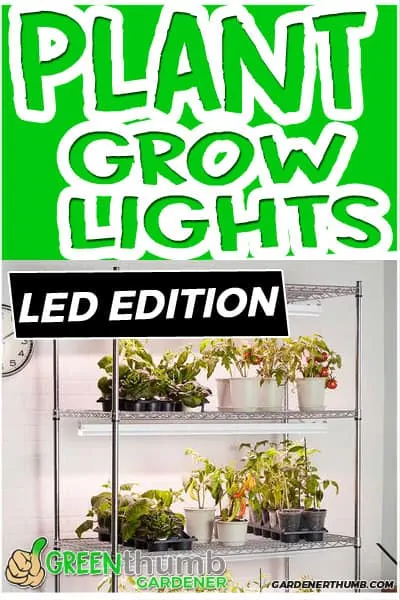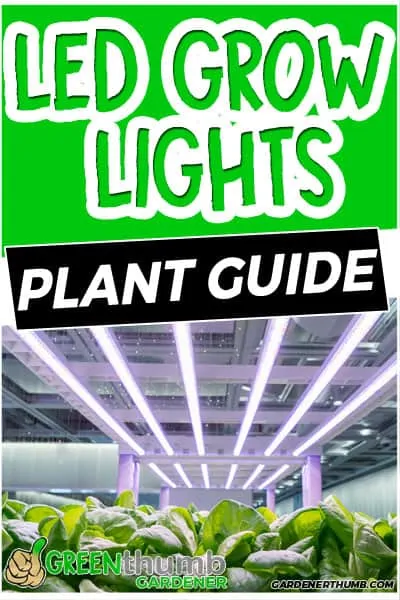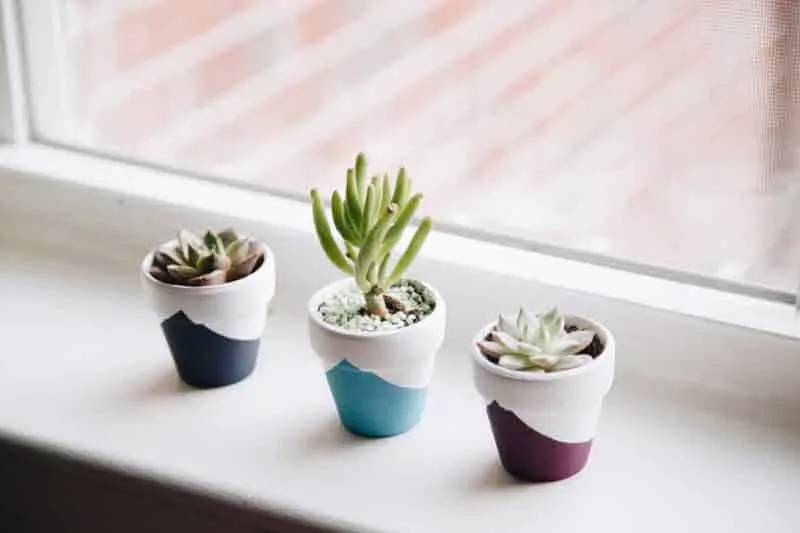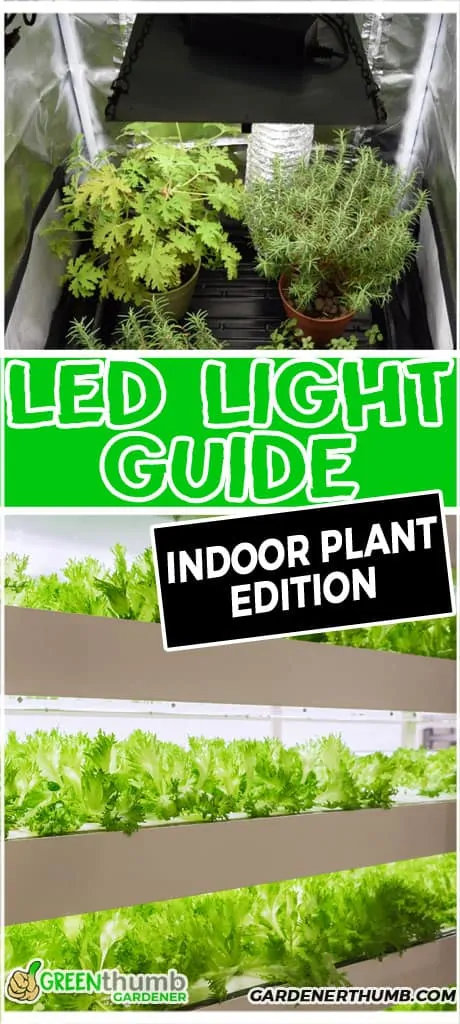Using LED Grow Lights For Indoor Plants
Last updated: 01/28/21
Indoor growing can offer you a lot of interesting benefits, from pests control to weather/climate control.
By using LED lights for indoor gardening plants, you can provide your plants with the adequate lighting they’d need to effectively photosynthesize.
But how do you use the right type of grow lights with the spectrum your plants need to grow?
Green thumb Gardener occasionally links to product and/or services offered by vendors to assist you with all your gardening needs. Some of these may be affiliate links, meaning we earn a small commission if items are purchased.
Want to Download a Garden Hack Guide for FREE

Enter your email below and we will send you a guide to help you SAVE money in your garden.
What are LED Grow Lights?
If you want your plants to effectively process photosynthesis and also grow well, then LED (Light Emitting Diode) grow lights might be the best option you could go for.
So what exactly are LED grow lights?
LED lights are the latest Techno in the market today; nothing like other traditional lights: fluorescent bulbs, incandescents, and the likes!
They do not make use of filaments, gas, lead (as in incandescents), or mercury (as in CFLs) like fluorescent lights.
They seem to last longer than these conventional lights and are more versatile and durable than fluorescent bulbs.
They do not have any fragile parts that are prone to some sort of failure in the long run comapred to fluorescent lights.
The LED lamps are made up of LED chips which efficiently provide your plants with the strong illumination they need to grow.

The LED chips are made using 2 separate semiconductors: holes (having the positive charge), and electrons (having the negative charge).
These chips can be quite effective in the production of quality light. They offer a combination of the light spectrum (the colors) and strong brightness your plants need to thrive in an artificial growing environment.
When power is applied and electric current begins to pass through, materials that make up the LED collide, in a process referred to as “combination”, to release energy in the form of light quanta and photons.
LEDs are designed to replicate natural lights and provide your plants with a balanced light spectrum of red, green, and blue light.
LED lights can also provide the temperature and adequate light intensity that’s similar to that from the sun.
And, unlike other types, the light from LEDs can be centered directly on your grow alone, to ensure that right amount light is used.
LEDs can also be remarkably energy-efficient. They do not seem to consume excessive power like other grow lights. They can still provide the brightness and spectrum of light similar to that your plants will naturally get from sunlight if grown outdoors or near your windows.
Grow Light Color Spectrum: Warm Vs. Cool Lights
There are different qualities of grow light and this makes it a lot more difficult for a grower to immediately make their decision without having to choose the wrong option for their plants.
Choosing either type can depend on three things;
- The particular type of plant you’re growing,
- The particular stage you’re in in the cultivation process, and
- The specific requirements (photoperiod) for your plants to fruit and blossom into maturity.
Warm Vs. Cool Lights
You might have noticed that grow lights boxes are commonly labeled 2500K or 6000K.
This is because their temperature is usually measured using the Kelvin scale.
It’s not all that technical like you may seem to think.
Basically, these numbers actually refer to the relative coolness or warmth of your lights on the color spectrum of light.
The ones labeled with higher numbers would invariably offer cooler lights (bluish or whitish), while the ones with lower numbers, will, of course, produce warmer, yellowish lights.
These spectrums are preferably used in growing specific plants or at specific stages in the cultivations of some plants.

Grow lights with cooler spectrums can best be used for sprouting, improving foliar plant growth, and/or also growing plants like vegetables and herbs.
Low spectrum lights (warm), on the other hand, are most desirable for use in flowering and fully fruiting specific plants to harvest.
LEDs, usually, are full-spectrum lights. They could offer your plants a combination of the color spectrums for their optimal growth in the long run.
Why Should You Use LED Grow Lights?
LED grow lights offer a lot of marvelous benefits for growing plants, and knowing why they can be more advantageous than the other conventional types helps you to better understand how they can be used.
So why should you use LED grow lights anyway?
1.Extended Lifespan
LED grow lights can last way longer than other traditional light types. They’re usually said to have over 50,000 hours of light per lifespan. Amazing right?
Well, one of the reasons for this fascinatingly increased lifetime is because of the comparatively lower temperature they use for operating. The normal types of grow lights usually generate a lot of heat and this generally tends to quickly weaken their productivity and hours of light per day over time.
Unlike other lights, LED grow lights make use of low energy and also radiate less heat.
2. Energy-efficient
Tired of those bills you run up every time as a result of the traditional grow light source you’re using?
Even consider yourself and the stress you sometimes might have to go through with the normal light types.
You need an LED grow light that can help you to save a great deal of energy especially if you run if you use 12 hours of light per day
They consume less and produce the same amount of light source your plants need per day even if you use it for 18 hours.
Compared to the traditional lights, nothing needs to be burned by the diode for LEDs to be able to give light.
3. Amazing Versatility
LED grow lights are also quite flexible and used for sprouting your seedlings, growing plants to fruiting your plants.
Their full-spectrum, a combination of cool and warm, makes it possible for them to stimulate quicker and healthier growth, for plant seedlings or fully grown plants.
4. Full Spectrum
LED grow lights have a full spectrum and a balanced proportion of heat and light.
With LED, your plants will be able to effectively photosynthesize and grow like they would if otherwise grown outdoors where they’d have natural lights from the sun.
Their spectrum can be pretty strong and wide enough light to cover for both small and large scale indoor growing farms or grow room.
5. More Targeted & Regulated Wavelength
LED grow lights have a more concentrated light frequency than the traditional lights. You can focus solely on your plants without the lights having to waste on nothing.
The wavelength of LED grow lights can be regulated to feed any types of plants just the right amount of rays they need for their photosynthesis.
Traditional lights usually emit a mixture of green and yellow lights which plants do not exactly need that much.
What your plants need is a balanced absorption of the spectrum that LED grow lights have been specifically designed to produce.
6. Speedy Growth
Do you want marvelous growth for your plants?
With LED grow lights, you can have that easily.
LEDs normally emit less heat than normal lights. They also do not produce toxic light wavelengths that can be counterproductive to the health of your plants.
The full spectrum light production ensures great and healthy growth for your plants.
LEDs normally offer red and green (purplish) lights that are about the most important components for growing plants.
The red component is needed for the successful process of photosynthesis.
The blue light, on the other hand, can stimulate stem elongation, stomatal opening, and leaf expansion. This blue light can especially be quite beneficial for photoperiodic flowering in plants.
Instead of your plants struggling to grow, they get to develop awesome strengths and grow properly under great conditions that your grow light can provide.
7. Lightweight
LED grow lights are not as heavy as the traditional types. In fact, the light are almost weightless.
They’re not made with ballasts or separate reflectors that may considerably add to their weight and, possibly, size.
8. Environmentally Friendly
Quality LEDs are usually certified by RoHS. Unlike HID light, they can be recycled and do not have toxic materials like mercury in their makeup.

How To Use LED Grow Lights for Indoor Plants?
If you’ve just purchased your own LED grow light, the next thing would be for you to install it above your indoor garden area. Ensure that the lights are hung properly above your indoor gardening area to prevent your plants from damaging.
1. Early Vegetative Phase
At this stage, the plant growth should be paramount.
So, to ensure the lowest internodal length possible and provide more internodes, you will have to mount your LED lights a few inches above the growing area.
You might have to check the specifications of the model you purchase. It usually varies depending on the different wattages of the grow light models.
2. Late Vegetative Phase
As more leaves begin to appear on your plants, you’d have to increase the height such that it’s a few inches away from the canopy.
You can lower the light if there are more leaves on your plants. This ensures the light gets to the lower branches.
3. Flowering/Budding Stage
As the plants want to grow, you also have to moderately increase the height of the light. Don’t forget; a few inches from the canopy.
If you hang your lights too high, your plants may struggle to get the light.
If your grow light is hung too low, your plants might also suffer from burning and/or bleaching, if care is not taken.
So, ensure that you’re hanging the light appropriately by confirming with the specifications provided by the manufacturer of the specific brand you’re using.
4. Watering
In order not to damage your plants, it’s best that you slightly alter watering your plants.
LED grow lights are unlike HID lights that can produce excessive heat to easily dry out the water you spray on your plants.
So always water your plants less frequently than you do normally with traditional lights.
The best option may be for you to wait until you notice the water has completely dried up from the soil before watering the plants again.
5. Feeding/Fertilizing
Feeding or fertilizing your plants should also be moderate.
They may take time to dry up with LED lights. So don’t rush, take your time.
6. Growing in Winter
Because of the reduced amount of heat LED lights produce, you might want to get an alternative supply of heat for your growing area to supplement the spectrum from your LED.
This ensures the speedy and healthy growth of your plants throughout this cold season.

How to Choose a Grow Light for Indoor Gardening Plants
Using grow lights can be quite expensive. But, you’d actually start getting your money’s worth on those seemingly expensive grow lights in the long run.
When they start fulfilling the purposes for which you had purchased them, especially when you get your first bountiful harvest, you’ll then fully understand why you should actually need a grow light in the first place.
Step-by-step Instructions
Step 1: Hang your grow lights over your grow area at a relatively safe distance.
Step 2 : For sprouting your seeds, you can look up the growing instructions for the specific plant you’re growing to determine how much light they need to grow properly.
For already sprouted plants, you can also check the necessary instructions for using the particular grow light you’ve purchased to be entirely sure.
The general standard for most growers is to hang their grow lights as high as 12 inches. This may, however, differ for you depending on the type of plant you’re growing as well as the growing stage of the plant.
Step 3: Draw up a flexible schedule according to how long you have to feed your plants with the lights.
You don’t want to feed them too much and too little. Giving more than enough light to your plants can stunt their growth and ultimately damage them.
Giving way less can also equally do the same. You can check for the standard schedules for growing specific plants indoors.
Step 4: Set up the timer of your grow light. Typically, a grow led light comes with timers that help growers to easily control the amount of light their plants get without having to turn the on/off switch.
So, set up a timer that’ll help you in controlling the light intensity as well as the duration you want to leave it on for.
Step 5: You also have to continually reposition the lights as your plants want to grow higher and higher during the vegetative stage.
Step 6: Once you hang your lights, don’t leave your plants to do the job on their own. They also need constant monitoring.
You have to constantly monitor them every now and then to ensure they are getting the spectrum they need to process or manufacture nutrients through photosynthesis.
Final Thoughts
Wouldn’t you like to grow without having to worry about changes in climate, weather, and the invasion of pests and parasites?
With LED grow lights, it is still entirely possible to replicate all the outdoor conditions needed for growing your plants.
This particular type of grow lights offers so many benefits and helps you to save your energy, as well as your precious money at the same time.
So, if you haven’t joined the amazing gang of indoor grow light users, now may be the time to enroll.








